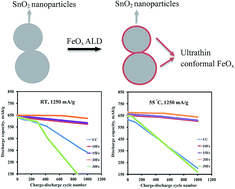Enhanced cycle life and capacity retention of iron oxide ultrathin film coated SnO2 nanoparticles at high current densities†
Abstract
Tin oxide (SnO2) has a high theoretical capacity (∼782 mA h g−1), but it experiences large volume changes during charge and discharge cycles that cause rapid capacity fade, which limits its practical use as an anode material. In an attempt to solve this, we coated these particles with ultrathin electrochemically active iron oxide (FeOx) films that act as an artificial solid electrolyte interphase layer, thus stabilizing the SnO2 particles for better longevity of significantly improved performance at high current densities in a practical voltage window. Since there exists a tradeoff between species transport and protection of particles (expecting long life), a film with an optimum thickness was achieved by atomic layer deposition (ALD) of FeOx on SnO2 particles. With an optimum thickness of about 0.24 nm after 20 cycles of iron oxide ALD (20Fe), an initial capacity of ∼658 mA h g−1 was achieved at a high current density of 1250 mA g−1. After 1000 cycles of charge/discharge at 1250 mA g−1, the 20Fe sample showed a capacity retention of 94% as compared to 52% of the uncoated sample when cycled at room temperature; at 55 °C, the capacity retention of the 20Fe sample was 93% compared to 33% of the uncoated sample.


 Please wait while we load your content...
Please wait while we load your content...